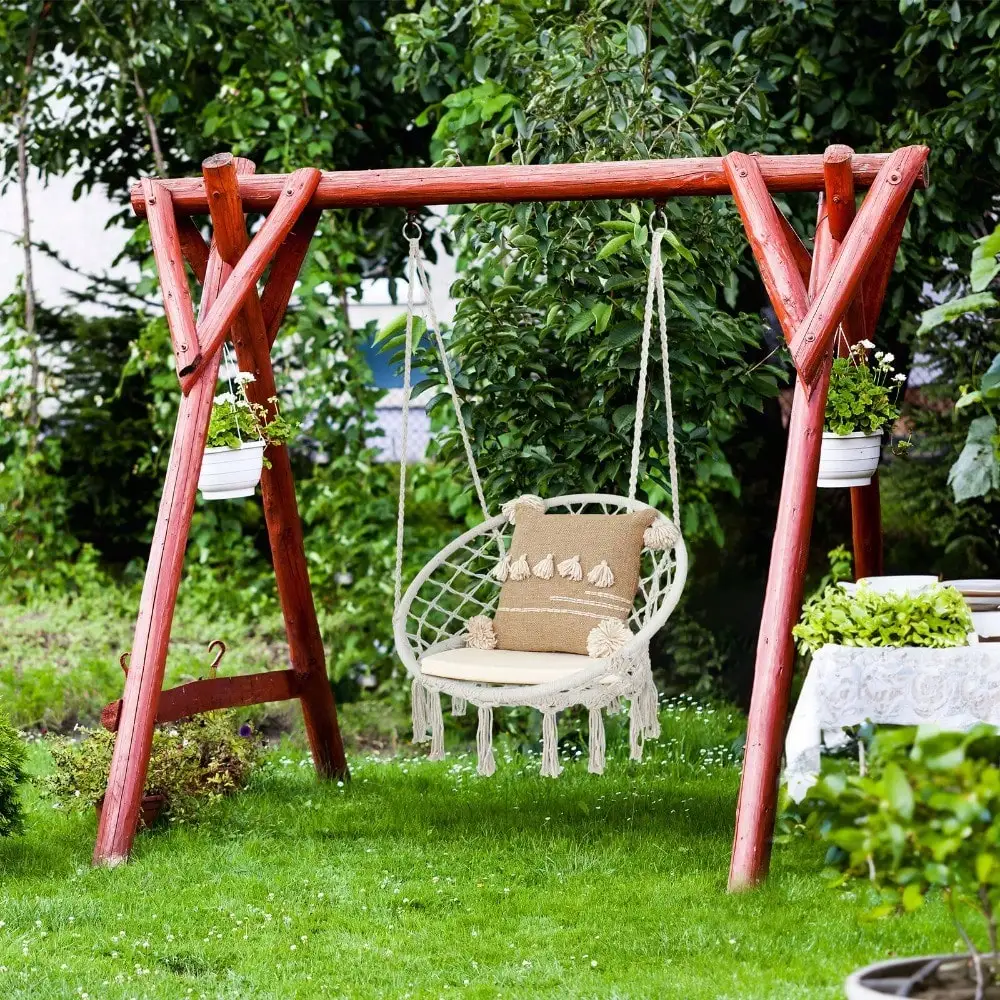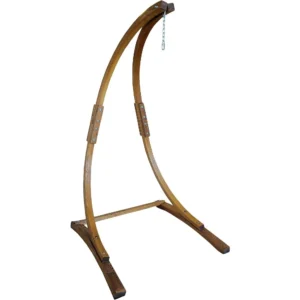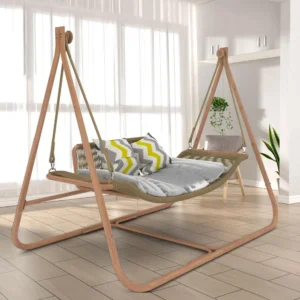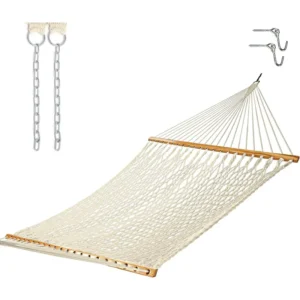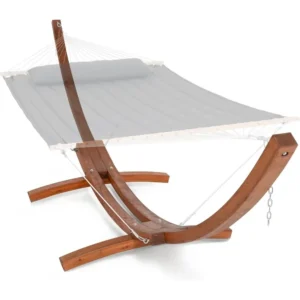Why Hammock Chair Materials Matter for Your Porch
Your porch hammock chair serves as more than just a decorative piece—it’s where you’ll spend countless hours relaxing, reading, or simply enjoying the outdoors. The materials you choose will directly impact how well your hammock chair stands up to the elements and how comfortable you’ll feel while using it.
Porch environments present unique challenges for furniture. Depending on your setup, your hammock chair might face direct sunlight that causes fading and weakening of fibers, moisture that leads to mold and mildew, and temperature changes that stress materials over time. The wrong material choice can lead to premature wear, requiring replacement after just one season, while the right materials might provide years of enjoyable use.
Consider the investment aspect as well—premium materials often come with higher upfront costs but save money in the long run. For example, a basic cotton hammock chair might cost less initially but could require replacement within a year when exposed to elements, while a quality synthetic option might last 5+ years in the same conditions.
Understanding how hammock chairs for covered porches differ from those designed for open spaces will help you make more informed decisions. Even on a covered porch, indirect sunlight, humidity, and occasional rain exposure can affect your chair’s longevity.
The material also dramatically impacts your relaxation experience—from the feel against your skin to how the chair breathes in hot weather. And don’t forget visual appeal—your chosen materials should complement your porch aesthetic, serving as a natural extension of your home’s style.
Ultimately, selecting weather-resistant hammock chairs for your porch involves balancing durability, comfort, maintenance requirements, and visual appeal to create your perfect outdoor retreat.
Essential Factors for Selecting Your Perfect Hammock Chair Material
When evaluating hammock chair materials, several key factors should guide your decision:
Weather Resistance
– UV protection to prevent color fading and fiber breakdown
– Moisture resistance to prevent mold, mildew, and rot
– Temperature stability to prevent cracking, warping, or excessive stretching
Durability Considerations
– Weight capacity appropriate for intended users (typically 250-500 pounds)
– Resistance to stretching or sagging over time
– Fraying resistance at stress points and edges
Comfort Elements
– Texture against skin (soft vs. rough)
– Breathability for temperature regulation
– Support structure and give
Maintenance Requirements
– Cleaning ease and method complexity
– Need for special treatments or protectants
– Storage requirements during off-seasons
Aesthetic Factors
– Available colors and patterns
– Texture and visual appeal
– Compatibility with existing porch decor
Environmental Impact
– Sustainability of material sourcing
– Recyclability at end of life
– Production methods and environmental footprint
Budget Considerations
– Initial investment vs. expected lifespan
– Replacement costs over time
– Value balance between quality and price point
Understanding the properties of best materials for outdoor hammocks helps create a framework for comparing specific options. A material that excels in one category (like weather resistance) might sacrifice in another (like natural feel), so prioritizing what matters most to you is essential.
When examining materials, consider your specific usage patterns. Will the chair be used daily or occasionally? Will it be left outdoors year-round or stored seasonally? These factors dramatically impact which material characteristics should take priority in your selection process.
Natural Fiber Options: Authentic Feel with Special Care Requirements
Natural fibers offer unmatched authenticity and a connection to traditional craftsmanship, but they require specific care to thrive in outdoor settings.
Cotton Hammock Chairs
Cotton hammock chairs provide several distinct advantages:
– Exceptional softness and comfort against skin
– Natural, breathable material that prevents overheating
– Traditional appearance with rich, warm aesthetics
– Often more affordable initially than synthetic options
However, cotton has significant limitations for outdoor use:
– Poor resistance to moisture (absorbs water, dries slowly)
– Susceptible to mildew and mold in humid environments
– Limited UV resistance leading to color fading and fiber weakening
– Requires regular maintenance and inspection
Cotton hammock chairs work best on covered porches with minimal weather exposure. With proper care—including bringing them indoors during inclement weather and regular cleaning—cotton chairs can last 2-3 seasons. Apply fabric protectant sprays designed for outdoor use to extend lifespan.
Natural Rope Options
Traditional rope hammock chairs crafted from materials like cotton, hemp, or jute offer:
– Classic nautical or bohemian aesthetic appeal
– Excellent airflow through the open weave pattern
– Distinctive texture and natural appearance
– Environmentally sustainable material sources
Their limitations include:
– High vulnerability to weather damage and rot
– Relatively short lifespan when exposed to elements
– More demanding maintenance requirements
– Tendency to stretch and sag over time
For natural rope hammock chairs to last, they should be used in sheltered locations and treated regularly with appropriate protectants. Many rope hammock sets with various materials provide traditional appearances with varying degrees of weather resistance.
Care tip: For natural fiber hammock chairs, regular inspection is crucial. Check for signs of mildew or weakening fibers, especially at weight-bearing points. A well-maintained cotton hammock chair in a protected location can last 3-4 years, while neglected ones may fail within months of outdoor exposure.
When selecting natural fibers, consider your willingness to perform regular maintenance as the primary factor. These materials reward careful stewardship with unmatched comfort and aesthetic appeal but punish neglect with rapid deterioration.
Premium Synthetic Fabrics: The Durability Champions
Synthetic fabrics have revolutionized outdoor furniture by offering exceptional weather resistance without sacrificing comfort. These high-performance materials represent the gold standard for long-lasting porch hammock chairs.
Acrylic Fabrics (Sunbrella, Outdura)
Premium acrylic fabrics have become synonymous with quality outdoor furniture for good reason:
- Superior UV resistance through solution-dyed manufacturing (color permeates the fiber rather than being applied to the surface)
- Exceptional color retention even after years of sun exposure
- Excellent water repellency without feeling plastic or unnatural
- Resistance to mold and mildew growth even in humid environments
- Soft, cotton-like feel that remains comfortable against skin
These premium materials do come with higher price tags, but their performance justifies the investment:
– Typical lifespan of 5-10 years with basic maintenance
– Wide range of designer colors and patterns
– Cleanable with mild soap and water
– Often backed by substantial warranties (3-5 years)
The solution-dying process is what sets these fabrics apart—pigment is added during fiber creation rather than after weaving, meaning the color permeates the entire fiber rather than sitting on the surface where it can fade or wash away.
Polyester Options
Polyester fabrics offer an excellent middle ground between performance and affordability:
- Good UV resistance (though typically less than premium acrylics)
- Strong water repellency, especially with applied treatments
- Excellent durability against stretching and tearing
- Quick-drying properties when they do get wet
- Wide variety of textures and finishes
Modern polyester hammock chairs often feature specialized treatments:
– UV inhibitors to extend color retention
– Water-repellent coatings for enhanced moisture protection
– Antimicrobial treatments to prevent mold and mildew
Polyester typically offers 80-90% of the performance of premium acrylics at roughly half the price, making it an excellent value option.
Olefin (Polypropylene)
Olefin has gained popularity for outdoor applications due to its unique properties:
- Exceptional stain resistance (even against difficult stains like wine)
- Inherent moisture resistance without added treatments
- Very quick-drying capabilities
- Lightweight yet strong composition
- Good colorfastness and UV resistance
- Environmentally friendly production and recyclability
The material’s limitations include less softness than acrylic and sometimes fewer color options. However, its performance in wet environments makes it ideal for humid climates or poolside settings.
Understanding waterproof materials for hammock protection can help you make informed decisions about which synthetic option best suits your specific porch conditions. The right synthetic fabric can provide years of trouble-free enjoyment with minimal maintenance, making these materials particularly appealing for high-use hammock chairs or those in challenging environments.
Performance Synthetic Options: Technical Materials for Demanding Conditions
Beyond standard synthetic fabrics lie specialized materials engineered for specific performance characteristics. These technical options excel in particular aspects of outdoor durability while making different comfort trade-offs.
Nylon Hammock Chair Options
Nylon offers unique properties that make it perfect for certain hammock chair applications:
- Exceptional strength-to-weight ratio
- Natural elasticity that creates a gentle, cradling feel
- Resistance to abrasion and tearing
- Compact storage capability when not in use
However, nylon has important limitations:
– Lower inherent UV resistance than polyester or acrylic
– Can absorb water unless specially treated
– May develop pilling with frequent use
– Usually requires UV inhibitor treatments for longevity
Nylon excels in “parachute-style” hammock chairs, where its lightweight strength and slight elasticity create a comfortable, conforming seat. For porch use, look for nylon treated with UV inhibitors and water-resistant coatings to extend its outdoor lifespan.
Textilene/PVC-Coated Mesh
This specialized material consists of a polyester core with PVC coating, creating a mesh with outstanding performance characteristics:
- Near-complete imperviousness to water and moisture
- Exceptional resistance to UV damage and fading
- Non-stretching design that maintains its shape indefinitely
- Superior airflow and breathability through open weave
- Simple maintenance with just soap and water
The downsides include:
– A less traditional appearance than fabric or rope
– Firmer feel against the skin
– Limited color palette (though improving in recent years)
Textilene mesh hammock chairs excel in fully exposed locations with intense sun exposure or frequent rain. They’re ideal for users who prioritize minimal maintenance and maximum lifespan over the softest possible texture.
Synthetic Rope Materials
Modern synthetic ropes offer dramatic improvements over natural fiber versions:
- Polyester Rope: Excellent UV resistance and minimal stretch, good for maintaining chair shape
- Nylon Rope: Superior strength and elasticity, creating a more “giving” feel
- Polypropylene Rope: Exceptional water resistance and floating capability, ideal for poolside use
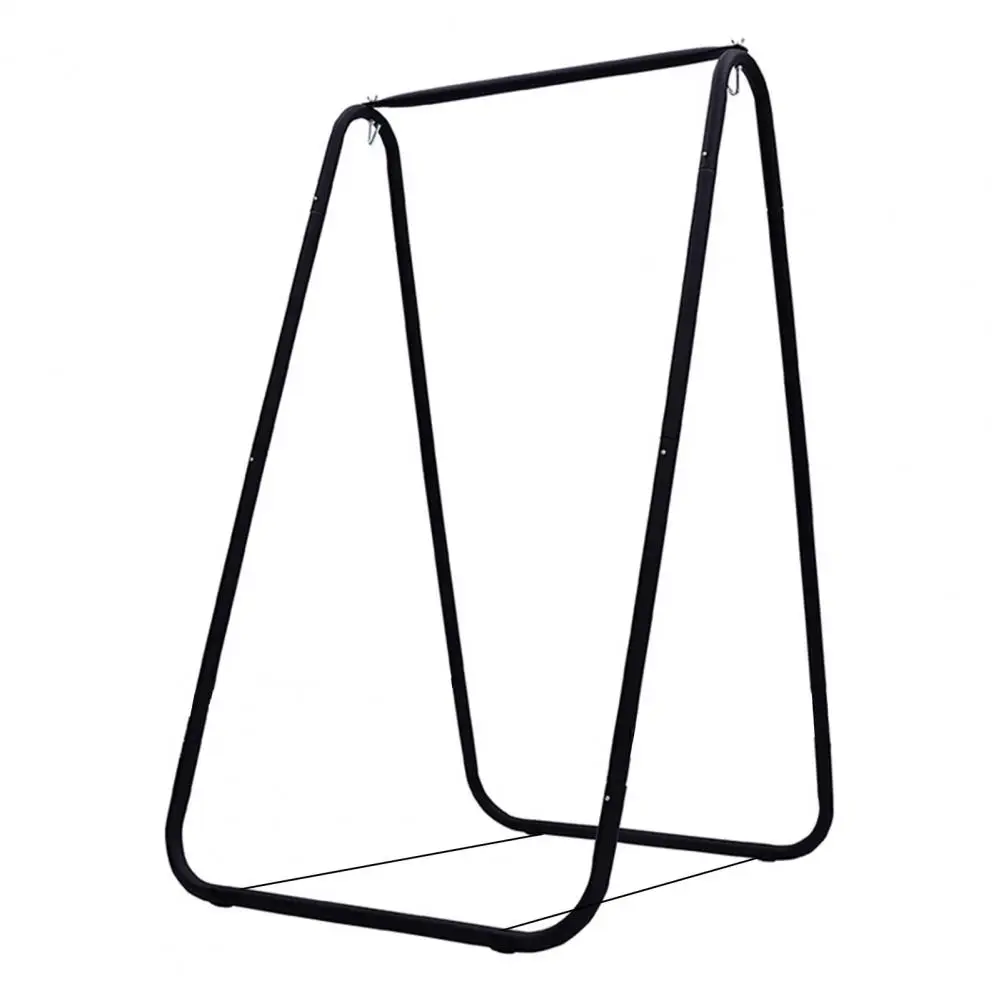
Synthetic ropes can maintain their integrity for 3-5 years in full outdoor exposure, compared to 1-2 seasons for natural rope varieties. They’re also significantly easier to clean—most can be hosed off or wiped down rather than requiring specialized treatments.
For those interested in exploring various options, our hammock chairs with stands collection features different material compositions suitable for various environments.
The best technical synthetic for your needs depends on your specific prioritization of weather exposure, comfort preferences, and aesthetic requirements. These materials represent the cutting edge of outdoor performance, often borrowing technology from marine, athletic, and industrial applications.
The Woven Collection: Natural vs Synthetic Wicker and Rattan
Woven hammock chairs offer distinctive visual appeal and texture, creating a sophisticated look for any porch. The choice between natural and synthetic woven materials represents one of the clearest examples of the appearance versus durability trade-off.
Natural Rattan and Wicker
Natural woven materials provide unmatched authenticity:
– Rich, organic appearance with subtle color variations
– Traditional craftsmanship and artisanal quality
– Lightweight yet sturdy construction
– Connection to natural materials and time-honored techniques
Their limitations for outdoor use are significant:
– High vulnerability to moisture damage, warping, and splitting
– Poor UV resistance leading to brittleness and breaking
– Regular maintenance requirements including specialized oils and protectants
– Limited lifespan in outdoor environments (typically 1-3 years)
Natural wicker and rattan work best on completely covered porches in dry climates. Even then, they require regular application of protective oils and should be brought indoors during extended damp periods. Consider these materials only if you’re committed to their maintenance requirements.
Synthetic PE Rattan
High-density polyethylene (HDPE) synthetic rattan has revolutionized woven outdoor furniture:
– Exceptional weather resistance to both sun and moisture
– Maintains flexibility without becoming brittle over time
– Requires virtually no maintenance beyond occasional cleaning
– Available in diverse weave patterns and color options
– Typical lifespan of 5-10 years in outdoor settings
Quality variations in synthetic rattan are significant. Look for these indicators of superior construction:
– Uniform weave pattern without irregular gaps
– UV inhibitors mentioned in product specifications
– Aluminum or powder-coated steel frame (rather than unprotected metal)
– Tight wrapping at connection points to prevent unraveling
The best synthetic rattan pieces are nearly indistinguishable from natural versions at first glance but will maintain their appearance for years while natural versions deteriorate rapidly.
Comparative Analysis for Porch Applications
When choosing between natural and synthetic woven materials, consider:
- Porch exposure level: Natural materials need almost complete protection from elements
- Desired maintenance level: Natural requires seasonal treatments; synthetic needs only occasional cleaning
- Aesthetic priorities: Natural offers subtle variation; synthetic provides consistent appearance
- Budget perspective: Natural often costs more initially but has shorter lifespan
- Environmental considerations: Natural is biodegradable; quality synthetic lasts longer before disposal
Our deep-seated woven hammock chair collection offers options in both natural and synthetic materials to suit different preferences and environments.
For most porch applications, high-quality synthetic wicker represents the most practical choice, offering the aesthetic appeal of woven furniture without the significant maintenance demands and limited lifespan of natural materials.
Frame Materials and Hardware: The Unsung Heroes of Hammock Chair Durability
While fabric and weave options often get the most attention, the structural components of your hammock chair are equally critical to its longevity and safety. The frame and hardware materials determine weight capacity, stability, and resistance to structural failure.
Frame Material Options
Powder-Coated Steel Frames
– Superior strength and weight capacity (typically 300-500 pounds)
– Excellent stability for minimal movement
– Affordable price point compared to other frame materials
– Potential for rust if coating is compromised
– Heavier weight making repositioning more difficult
To maximize steel frame longevity, look for:
– Multiple layers of powder coating rather than paint
– Rust-resistant undercoating
– Sealed welds and connection points
– Drain holes to prevent water accumulation
Aluminum Frames
– Natural corrosion resistance without coatings
– Significantly lighter weight for easier movement
– Modern, sleek aesthetic options
– Generally lower weight capacity than steel (250-350 pounds)
– Higher price point than comparable steel options
Wooden Frame Options
– Distinctive natural aesthetic that complements traditional porch designs
– Good strength when properly maintained
– Ages with character (particularly teak and cedar)
– Requires periodic sealing or treatment
– Vulnerable to cracking and splitting without maintenance
Premium woods like teak and cedar contain natural oils that improve weather resistance, while eucalyptus offers similar properties at a more accessible price point.
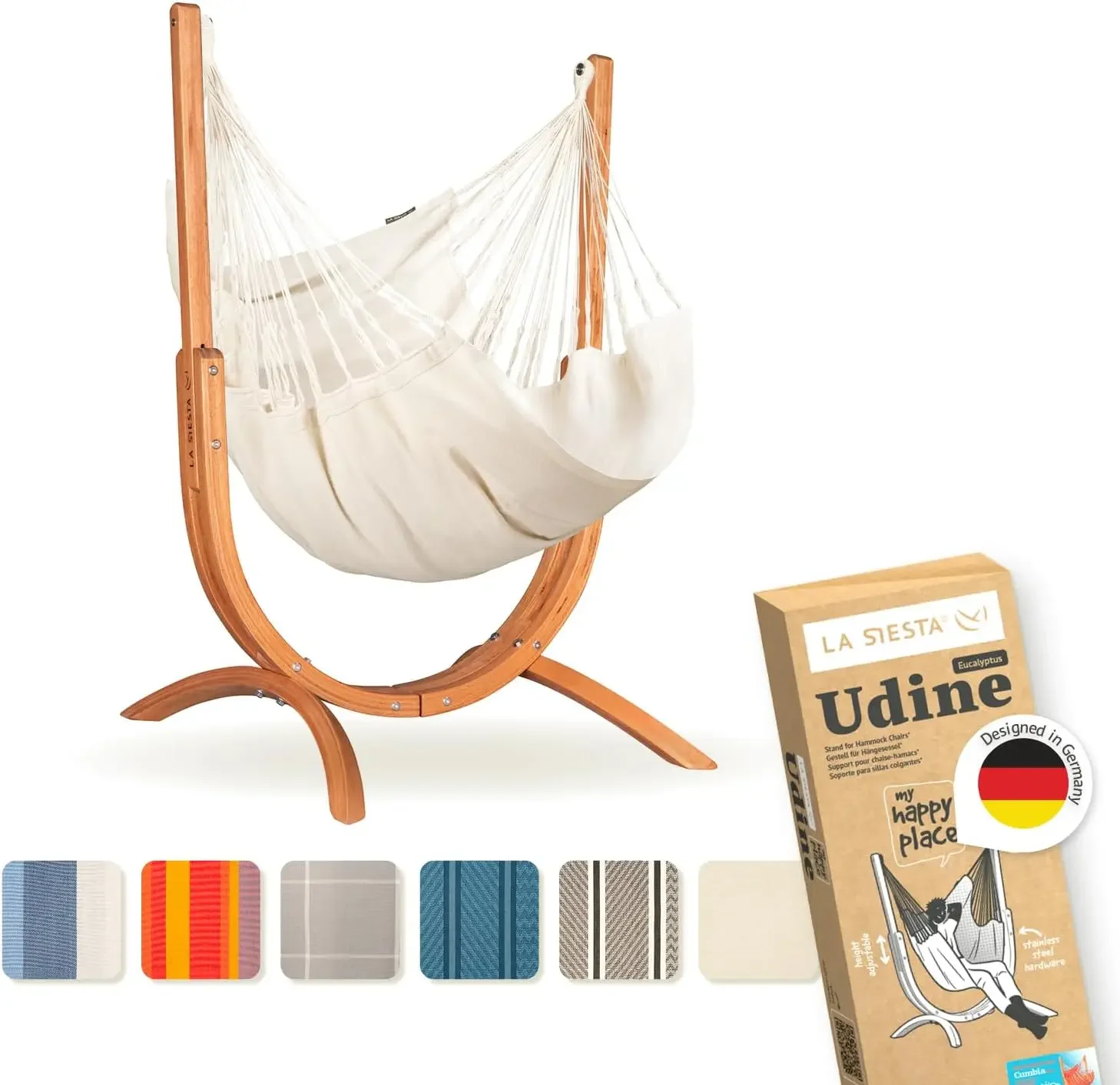
Critical Hardware Components
The connection points in your hammock chair often determine its ultimate durability:
Chain Systems
– Stainless steel: Superior corrosion resistance but higher cost
– Galvanized steel: Good corrosion resistance at moderate cost
– Powder-coated steel: Attractive appearance but may chip over time
Hooks and Carabiners
– Look for closed designs that prevent accidental unhooking
– Marine-grade stainless steel offers best longevity
– Weight ratings should exceed chair rating by at least 20%
Spring Components
– Stainless steel springs resist corrosion and maintain elasticity
– Look for protective covers to prevent pinching
– Quality springs provide subtle bounce without excessive movement
Weight Capacity Considerations
Frame material directly impacts safe weight capacity:
– Premium steel frames: Up to 500 pounds
– Standard steel frames: 250-350 pounds
– Aluminum frames: Typically 250-300 pounds
– Wooden frames: Varies widely (200-450 pounds)
Always respect stated weight limits—exceeding them compromises both safety and longevity. Signs of overstressing include creaking sounds, visible bending, or excessive movement during use.
Our collection of wooden hammocks and stands showcases various frame materials paired with appropriate fabric and hardware components for optimal durability.
Remember that even the most weather-resistant fabric will fail prematurely if attached to substandard hardware or frames. Investing in quality structural components provides both safety and longevity benefits that justify the additional cost.
Material Matchmaking: Selecting Based on Your Specific Porch Environment
Not all porches present the same conditions for hammock chairs. Your specific porch configuration and local climate should significantly influence your material selections.
Fully Covered and Screened Porches
These protected environments offer the widest material options:
- Natural fibers become viable with minimal weather exposure
- Cotton and traditional rope materials can thrive with basic maintenance
- Comfort can take priority over weather resistance
- Natural wicker and rattan may be suitable with proper care
- Decorative aspects can receive greater emphasis
- Frame materials can include less weather-resistant woods
Even in covered settings, consider:
– Humidity levels that might still promote mildew
– Reflected UV exposure from nearby surfaces
– Temperature fluctuations that stress materials
– Wind-driven rain that may occasionally reach the chair
Partially Covered Porches
These mixed-exposure environments require more careful material selection:
- Premium synthetics like Sunbrella or high-quality polyester offer good balance
- Synthetic wicker with aluminum frames provides durability with traditional appearance
- Materials with moderate UV resistance can work if positioned away from direct sun
- Water-resistant rather than fully waterproof materials may suffice
- Consider materials that dry quickly after occasional moisture exposure
The sun path across your porch is especially important—areas receiving afternoon sun require more robust UV protection than morning-sun locations.
Fully Exposed Porches and Pergolas
These challenging environments demand the most durable materials:
- Solution-dyed acrylics or treated polyester for fabric components
- Synthetic PE wicker for woven styles
- Textilene mesh for maximum weather resistance
- Powder-coated steel or aluminum frames
- Marine-grade stainless steel hardware
- Weather-protective treatments and regular maintenance
Even with the most durable materials, consider supplemental protection like:
– Removable weather covers for extended protection
– Shade solutions to reduce direct UV exposure
– Seasonal storage in extreme climates
Climate-Specific Considerations
Hot, Sunny Regions
– Prioritize superior UV resistance (solution-dyed acrylics)
– Consider breathable materials to prevent heat buildup
– Look for fade-resistant color technologies
– Choose lighter colors that reflect rather than absorb heat
Humid, Rainy Areas
– Quick-drying synthetic materials prevent mildew growth
– Open weave patterns promote airflow and faster drying
– Mold-resistant treatments provide additional protection
– Avoid natural fibers that absorb and retain moisture
Coastal Environments
– Marine-grade hardware resists salt corrosion
– Salt-resistant fabric treatments protect against spray
– Aluminum frames resist salt air better than steel
– Regular freshwater rinsing extends material life
Inspiring covered porch hammock chair installations demonstrate how material selections can be optimized for specific environmental conditions while maintaining aesthetic appeal.
The most successful material selection matches both your porch environment and your maintenance willingness. Even the most durable materials benefit from appropriate care, while even delicate materials can thrive in the right protected setting.
Material Maintenance: Extending Your Hammock Chair’s Lifespan
Proper maintenance dramatically extends the useful life of any hammock chair material. A well-maintained chair can last 2-3 times longer than a neglected one, regardless of its composition.
Universal Care Principles
These practices benefit all hammock chair materials:
- Remove debris (leaves, dirt, pollen) regularly before it can stain or promote mildew
- Provide protection during severe weather events (storms, hail, high winds)
- Store or cover during off-season periods, especially in freezing climates
- Inspect regularly for early signs of wear, particularly at stress points
- Clean spills and stains promptly before they set
- Keep trees and shrubs trimmed away to prevent sap drips and abrasion
Material-Specific Cleaning Methods
Natural Fibers (Cotton, Rope)
– Brush off dry dirt with soft brush
– Spot clean with mild soap solution (2 tbsp mild detergent per gallon of water)
– Avoid harsh chemicals that break down natural fibers
– Allow to dry completely before using or storing
– Apply fabric protectant designed for outdoor cotton
Synthetic Fabrics
– Clean with mild soap and water solution
– Rinse thoroughly to prevent soap residue
– For Sunbrella and similar acrylics, bleach solutions (1:10 with water) can be used for tough stains
– Reapply water repellent treatments annually
– Avoid pressure washing which can damage fibers
Wicker and Rattan
– Natural: Clean with damp cloth, apply protecting oil seasonally
– Synthetic: Hose down or wipe with soapy water, rinse well
Metal Components
– Wipe clean and dry thoroughly after rain exposure
– Apply appropriate protectant (car wax works well for powder-coated surfaces)
– Touch up any scratches or chips promptly to prevent corrosion spread
Stain Treatment Approaches
For most materials, these stain removal tips help:
– Address stains immediately when possible
– Blot rather than rub to prevent spreading
– Work from outside of stain toward center
– Test cleaning solutions on inconspicuous area first
– For oil-based stains, apply absorbent powder before cleaning
Find more ideas for maintaining and styling with our hammock chair ideas for ultimate relaxation guide, which includes material-appropriate maintenance tips.
Remember that preventative maintenance is always more effective than remedial cleaning. Simple habits like keeping chairs clean and protected during severe weather can dramatically extend their usable life and maintain their appearance.
Decision-Making Tool: Material Comparison at a Glance
This comparison helps you quickly evaluate materials based on critical performance factors:
| Material Type | Weather Resistance (1-5) | Durability (1-5) | Comfort (1-5) | Maintenance Level | Cost Range | Ideal Environment |
|---|---|---|---|---|---|---|
| Cotton | 2 | 2 | 5 | High | $ | Covered, protected |
| Natural Rope | 1 | 2 | 4 | High | $ | Covered, protected |
| Acrylic (Sunbrella) | 5 | 5 | 4 | Low | $$$ | Any exposure level |
| Polyester | 4 | 4 | 4 | Low | $$ | Partial/full exposure |
| Olefin | 5 | 4 | 3 | Low | $$ | Any exposure level |
| Nylon | 3 | 4 | 5 | Medium | $$ | Partial exposure |
| Textilene Mesh | 5 | 5 | 3 | Very Low | $$ | Full exposure |
| Natural Wicker | 1 | 2 | 3 | High | $$$ | Covered only |
| Synthetic Wicker | 5 | 4 | 3 | Low | $$ | Any exposure level |
Rating System Explained:
– Weather Resistance: 1=Poor (requires full protection) to 5=Excellent (withstands full exposure)
– Durability: 1=1 season to 5=5+ years under appropriate conditions
– Comfort: 1=Stiff/rough to 5=Soft/conforming
– Maintenance: Low=occasional cleaning; Medium=seasonal treatment; High=regular attention
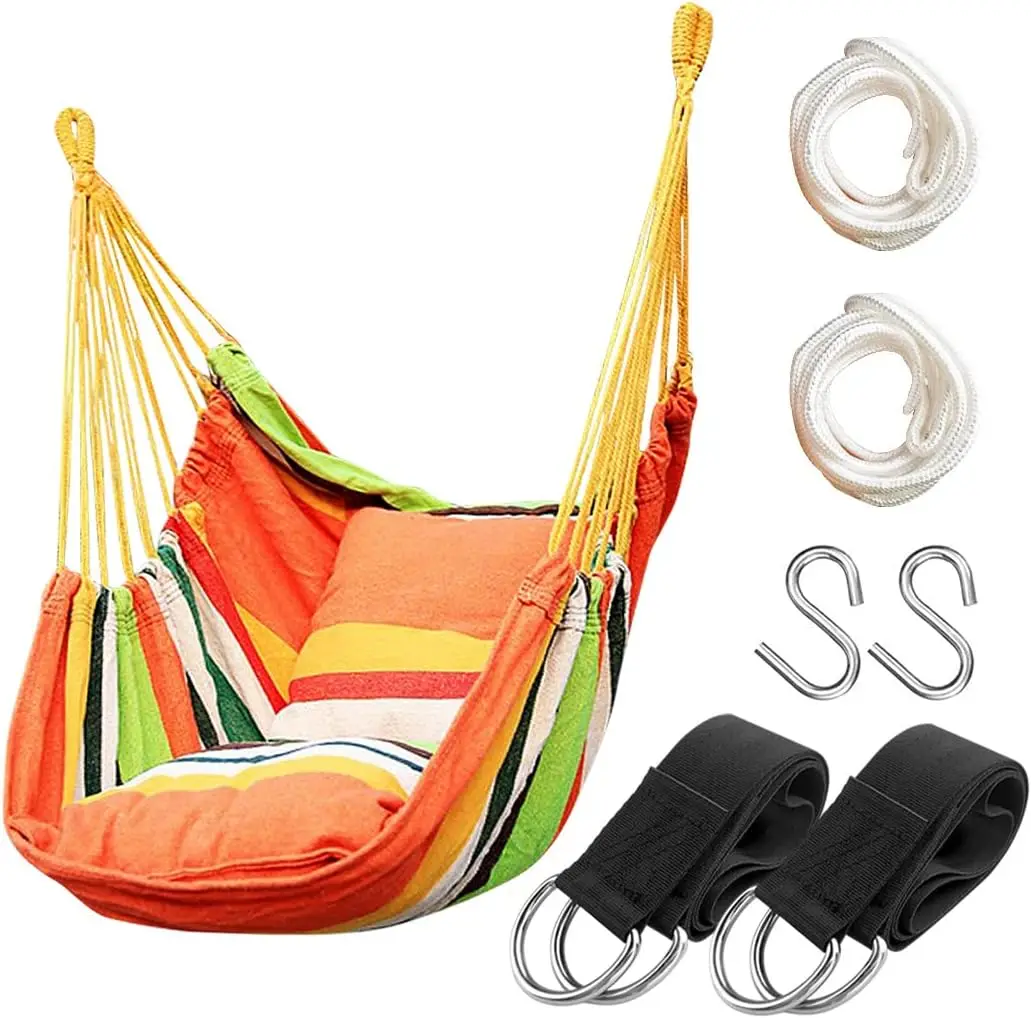
The materials that excel in multiple categories include:
– Solution-dyed acrylics (best overall balance of performance and comfort)
– Quality polyester (best value for moderate exposure)
– Synthetic wicker (best for traditional appearance with modern durability)
– Textilene mesh (best for extreme conditions with minimal maintenance)
Understanding how much weight a hammock chair can hold relates directly to material selection, as different materials provide varying levels of strength and durability under load.
When interpreting this comparison for your needs, first identify your non-negotiable factors (such as full weather exposure or maximum comfort), then select materials that excel in those areas while offering acceptable performance in other categories.
Expert Recommendations for Different Priorities and Budgets
Based on various common priorities, these material recommendations help simplify your decision process:
Best Overall Performance: Solution-Dyed Acrylic (Sunbrella)
This premium option delivers exceptional weather resistance, outstanding comfort, and a 5+ year lifespan with minimal maintenance. While the initial investment is higher ($150-300 for chair fabric alone), the per-year cost becomes reasonable given its longevity.
Best for Maximum Weather Exposure: Textilene Mesh
For fully exposed locations with intense sun and frequent rain, this PVC-coated polyester mesh withstands virtually anything nature delivers. It offers excellent airflow, complete water resistance, and can last 5-7 years with almost no maintenance beyond occasional rinsing.
Best Budget-Friendly Option: Treated Polyester
Quality polyester with UV and water-resistant treatments offers roughly 80% of the performance of premium acrylics at about half the price. Look for polyester with explicit UV ratings for best results. Expect 3-4 years of service in partially covered settings.
Most Comfortable Option: Cotton/Polyester Blend
For covered porches where comfort is paramount, these blends offer the soft feel of cotton with improved durability from polyester. While still requiring protection from direct weather, they provide an excellent balance of traditional comfort and moderate durability.
Dark Wood Hammock Sets, Porch Swing Chair Sets
$653.82 Select options This product has multiple variants. The options may be chosen on the product pageA-Frame Stand Hammock Sets, Swinging Hammock Chair Sets
$154.62 Select options This product has multiple variants. The options may be chosen on the product pageLight Wood Hammock Sets, Swinging Hammock Chair Sets
$1,359.35 Select options This product has multiple variants. The options may be chosen on the product pageClassic Wooden Stand Hammock Sets, Heavy Duty Hammock Sets
$1,061.68 Select options This product has multiple variants. The options may be chosen on the product pageDouble / Two Person Hammock Sets, Rope Hammock Sets
Double Traditional Cotton Rope Hammock with Extension Chains – 450 lbs Capacity for Backyard & Patio$292.98 Select options This product has multiple variants. The options may be chosen on the product pageHeavy Duty Hammock Sets, Wooden Arc Stand Hammock Sets
$878.66 Select options This product has multiple variants. The options may be chosen on the product page
Premium Choice: Sunbrella with Teak Frame
For discerning buyers seeking the ultimate in both performance and aesthetics, this combination offers unmatched durability and sophisticated appearance. The natural aging of teak complements the colorfast properties of Sunbrella for a chair that improves with age.
Most Stylish with Good Performance: Synthetic PE Rattan
High-quality synthetic wicker provides the sophisticated appearance of natural materials with significantly improved durability. Available in various weave patterns and colors, it offers excellent design flexibility without compromising weather resistance.
Best Low-Maintenance Option: Olefin
Inherently stain-resistant and highly water-repellent, olefin requires minimal care while offering excellent durability. Its quick-drying properties make it especially suitable for humid environments or households with children.
Explore our collection of swinging hammock chair sets to see how these material recommendations translate into actual products designed for different priorities and settings.
Common Material Selection Mistakes to Avoid
Even with quality materials, these common errors can lead to disappointing hammock chair experiences:
Prioritizing Appearance Over Durability
Many consumers select visually striking natural materials for fully exposed locations, leading to rapid deterioration. Assess your actual exposure conditions honestly rather than choosing based solely on aesthetic appeal.
Underestimating Local Weather Extremes
A hammock chair that performs well in moderate conditions may fail during weather extremes like intense UV radiation, heavy rain seasons, or high humidity periods. Consider your climate’s worst conditions, not just the average.
Focusing Only on Initial Purchase Price
Lower-quality materials might save money upfront but often cost more long-term when replacement frequency is considered. Calculate the “per year of use” cost rather than just the initial price tag.
Neglecting Frame and Hardware Considerations
Even the most weather-resistant fabric will fail prematurely if mounted on substandard supports. Ensure your hanging hardware and frame match the quality level of your chair materials.
Overlooking Maintenance Requirements
Beautiful natural materials like cotton rope or wicker require significant upkeep. Be realistic about your willingness to perform regular maintenance before selecting high-maintenance materials.
Mismatching Materials to Usage Frequency
Occasional-use chairs can utilize more delicate materials, while daily-use chairs need maximum durability. Consider how often the chair will actually be used when selecting materials.
Ignoring Weight Capacity Needs
Different materials and construction methods yield varying weight capacities. Consider all potential users when evaluating if a material provides sufficient strength.
Missing Compatibility with Existing Decor
A hammock chair should complement your overall porch aesthetic. Consider how materials will coordinate with existing furniture, flooring, and architectural elements.
For more practical insights on installation that complements your material choices, explore our setup tips for hammock chairs on roofs, which addresses mounting considerations for different materials.
Weather-Resistant Material Additions for Comfort Enhancement
The right accessories can enhance both comfort and weather resistance of your hammock chair:
Weather-Appropriate Cushions and Pillows
Strategic cushion selection can significantly improve comfort while maintaining weather resistance:
– Outdoor-specific cushions with quick-drying foam
– Solution-dyed acrylic covers (Sunbrella) that coordinate with chair materials
– Removable designs that can be stored during inclement weather
– Water-resistant inner liners that prevent moisture absorption
– Antimicrobial treatments to prevent mildew growth
For optimal cushion performance:
– Choose materials that complement your chair’s durability level
– Select cushions with drainage features to prevent water pooling
– Consider zipper quality and UV resistance of thread
– Look for machine-washable covers for easy maintenance
Protective Covers and Canopies
Additional protection extends material life:
– Custom-fitted chair covers for off-season or severe weather
– Integrated canopy options that provide shade while maintaining airflow
– Removable rain shields for unexpected showers
– Materials with UV-blocking properties to reduce fabric damage
– Quick-deployment designs for sudden weather changes
Storage solutions also protect materials:
– Weather-resistant storage containers for cushions and accessories
– Hook systems for keeping chairs elevated when not in use
– Breathable covers that prevent condensation buildup
The key to successful accessories is balancing protection with practicality—the most protective solutions won’t work if they’re too cumbersome to use regularly. Our porch swing chair sets feature coordinated accessories designed to enhance both protection and comfort.
Frequently Asked Questions About Hammock Chair Materials
What is the most durable material for an outdoor hammock chair?
Solution-dyed acrylic (like Sunbrella) offers the best combination of weather resistance, color retention, and longevity. Textilene mesh provides superior performance in extreme conditions but with a different feel and appearance.
Can I leave my hammock chair outdoors year-round?
It depends on both the material and your climate. Synthetic materials like acrylic, polyester, and synthetic wicker can remain outdoors in mild climates. However, even these durable materials benefit from protection during extreme weather or seasonal storage in harsh winter climates.
How do I clean different hammock chair materials?
Most synthetic materials can be cleaned with mild soap and water. Natural fibers generally require gentler hand cleaning. Sunbrella and similar premium acrylics can handle diluted bleach for tough stains. Always check manufacturer instructions, as cleaning methods vary significantly by material type.
Which material is best for a porch with direct sun exposure?
Solution-dyed acrylics like Sunbrella offer the best combination of comfort and UV resistance for sunny locations. Textilene mesh and olefin are also excellent options with different comfort profiles. All maintain color and structural integrity even with extended sun exposure.
Are rope hammock chairs comfortable for extended use?
Synthetic rope hammock chairs provide good comfort for moderate periods, while natural cotton rope offers superior initial comfort but less support over extended use as it stretches. For long reading or relaxation sessions, fabric hammock chairs typically provide better sustained comfort than rope versions.
What’s the most comfortable material that’s still weather-resistant?
Solution-dyed acrylic offers the best balance of soft texture and weather performance. Cotton/polyester blends provide excellent comfort with moderate weather resistance suitable for covered areas. For fully exposed locations, thicker grades of olefin offer good comfort with excellent weather resistance.
How can I protect my hammock chair during storms or off-season?
Removable weather covers provide the best protection. Additionally, bringing cushions indoors, storing in a protected location, or using weather-resistant storage containers are all effective strategies. Some hammock chairs can be easily removed from their hanging hardware for complete storage.
Which materials are safest for children’s hammock chairs?
Look for strong synthetic fabrics like polyester or nylon with reinforced stitching. Avoid natural ropes that can weaken unpredictably. Ensure hardware and frames exceed standard weight ratings for added safety margin. Textilene mesh offers excellent safety due to its non-stretching properties and predictable performance.
For additional material insights specific to patio environments, our guide to patio hammock chair materials provides complementary information applicable to various outdoor settings.

